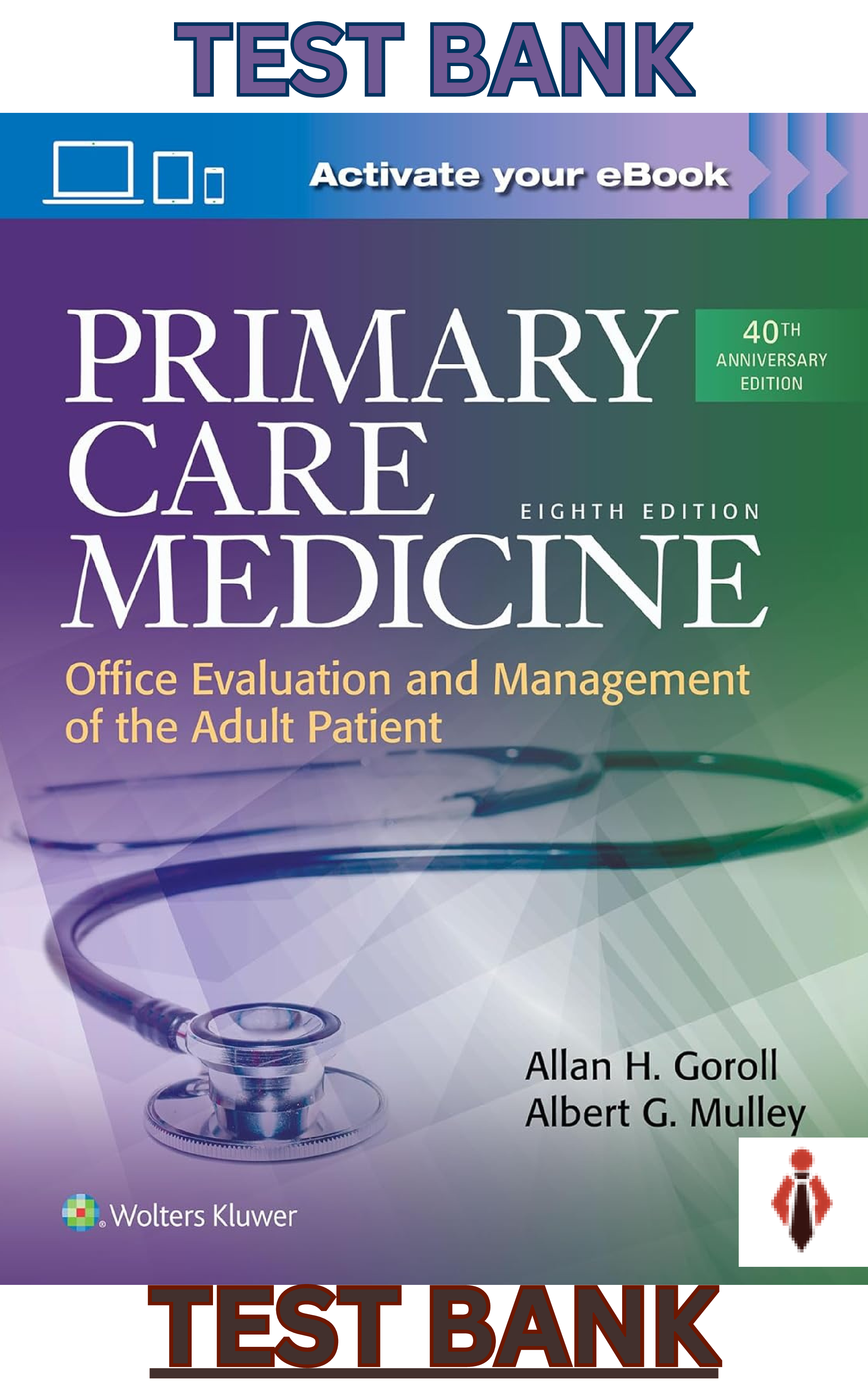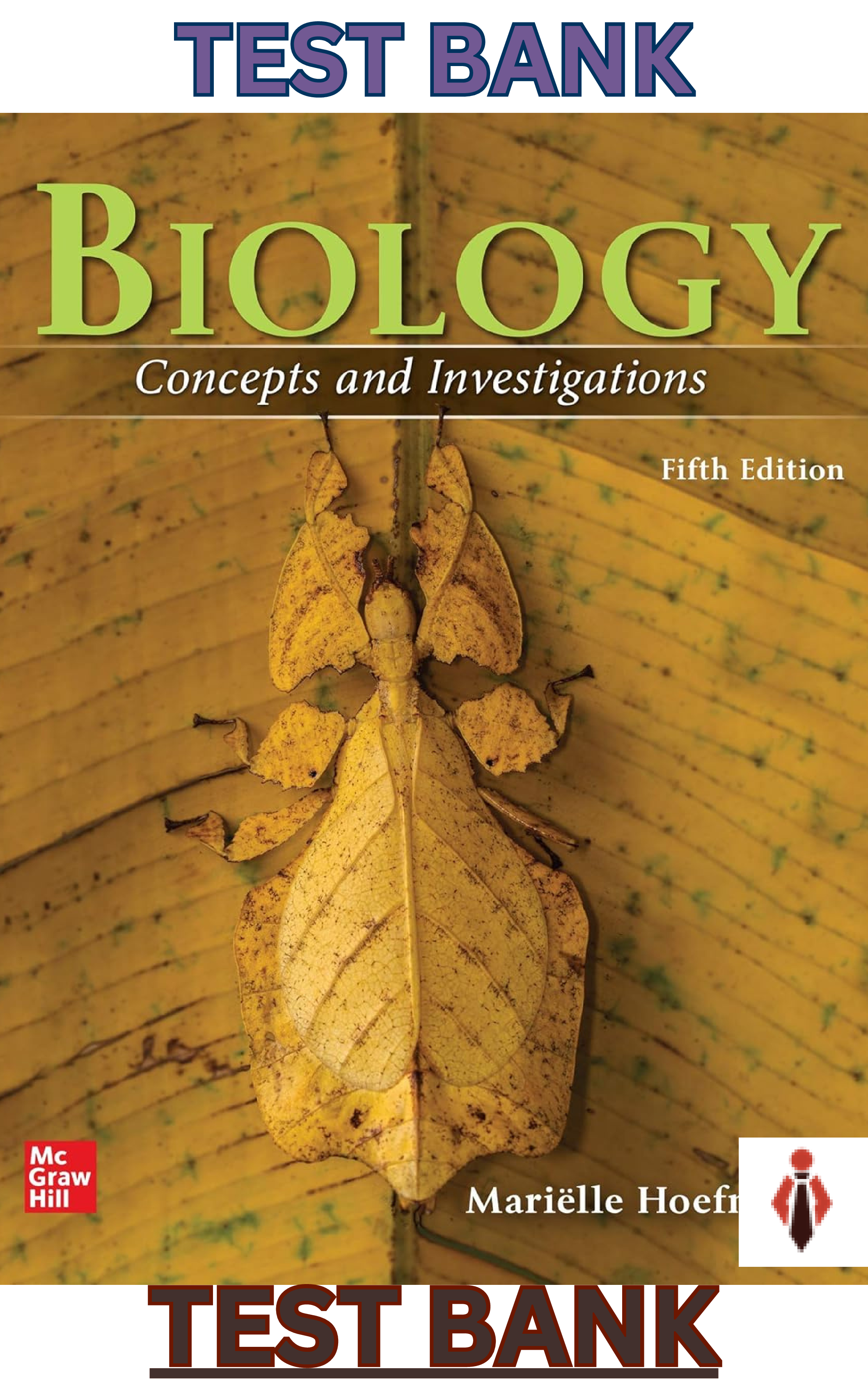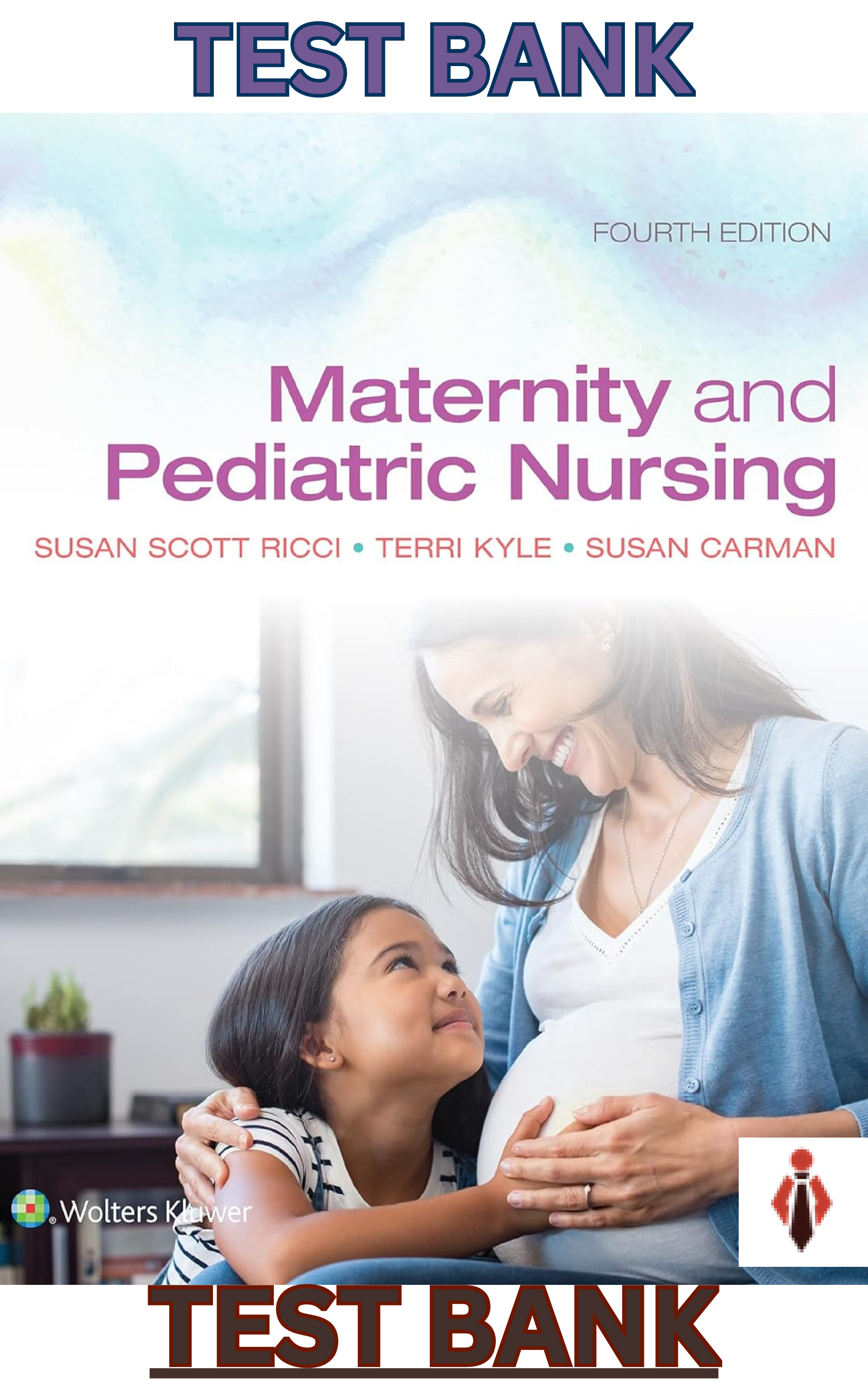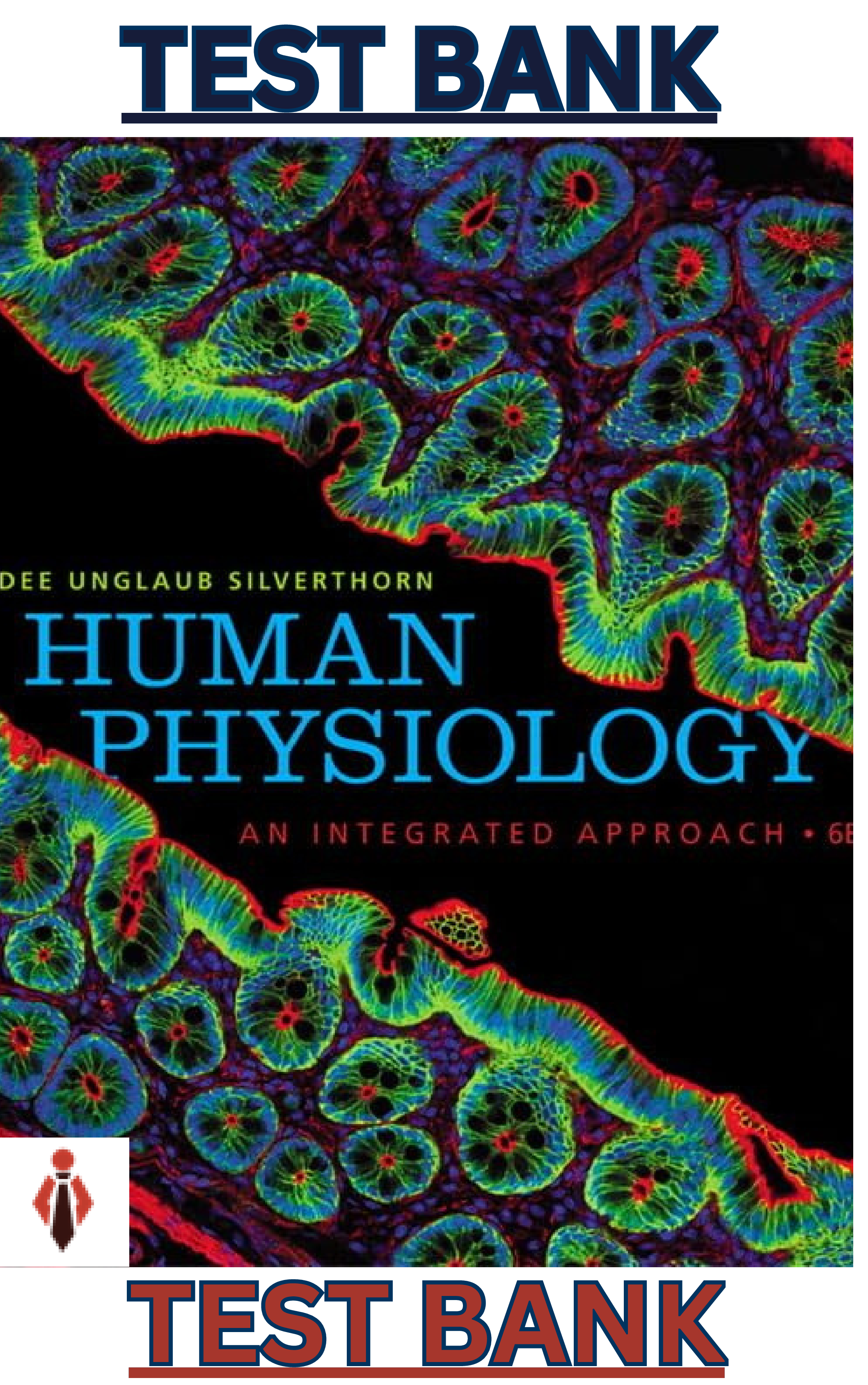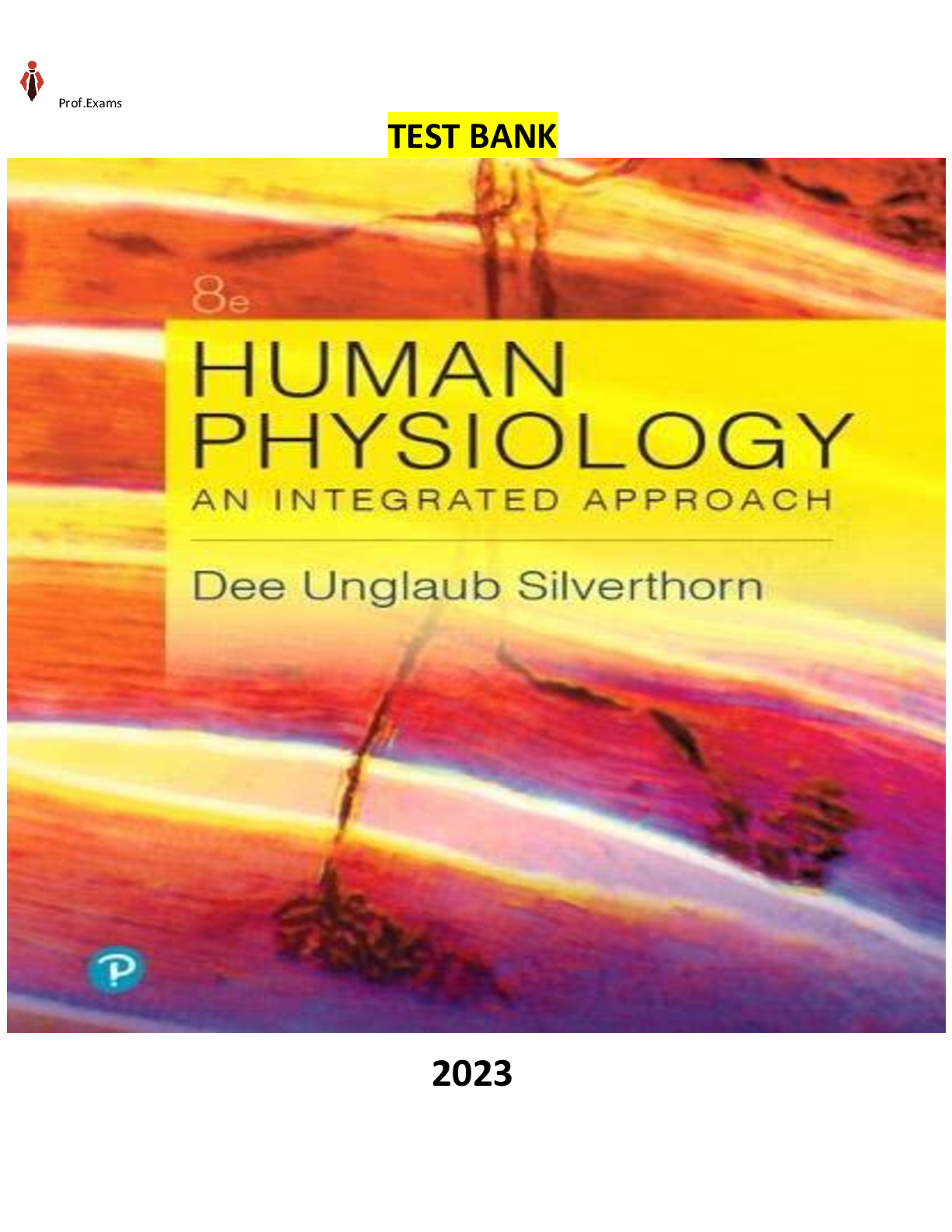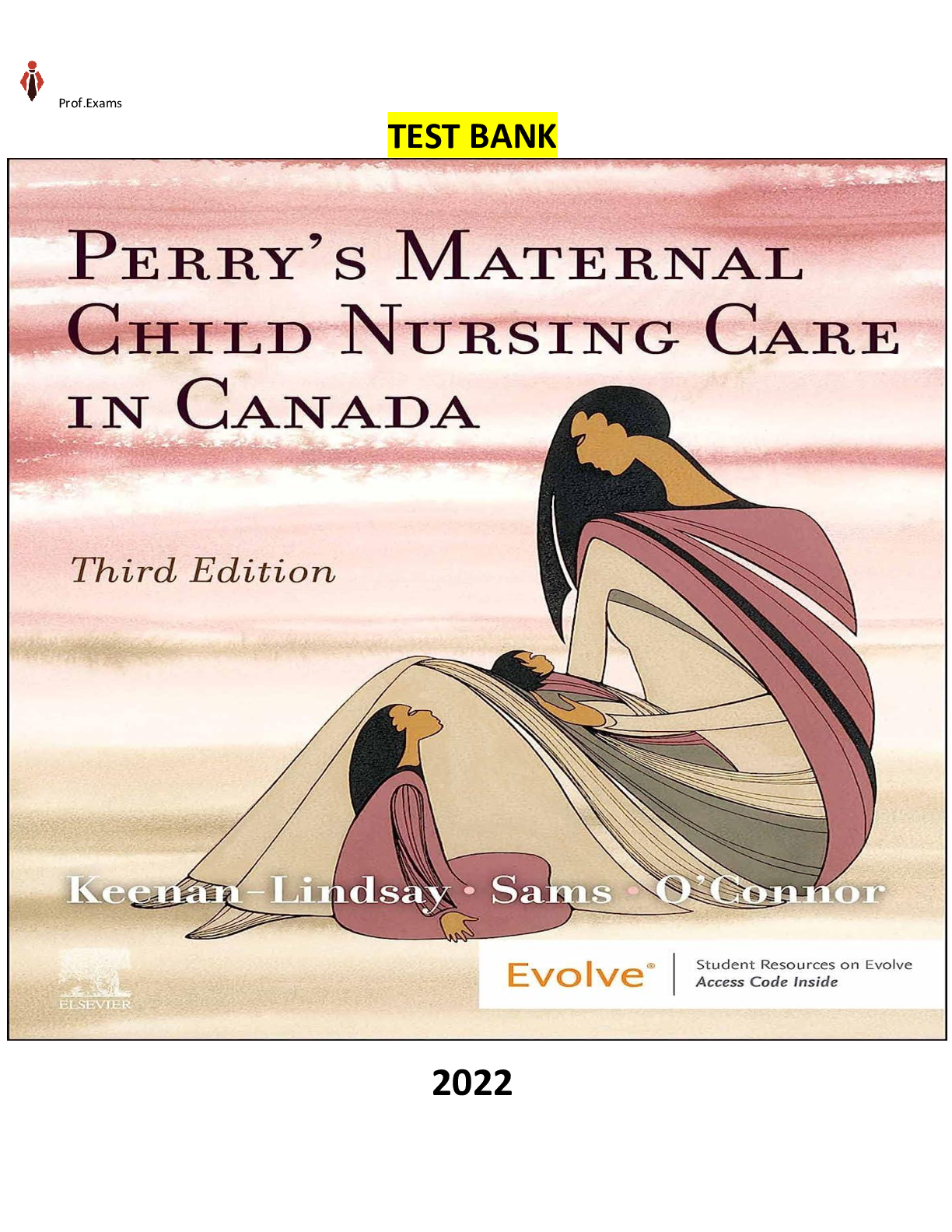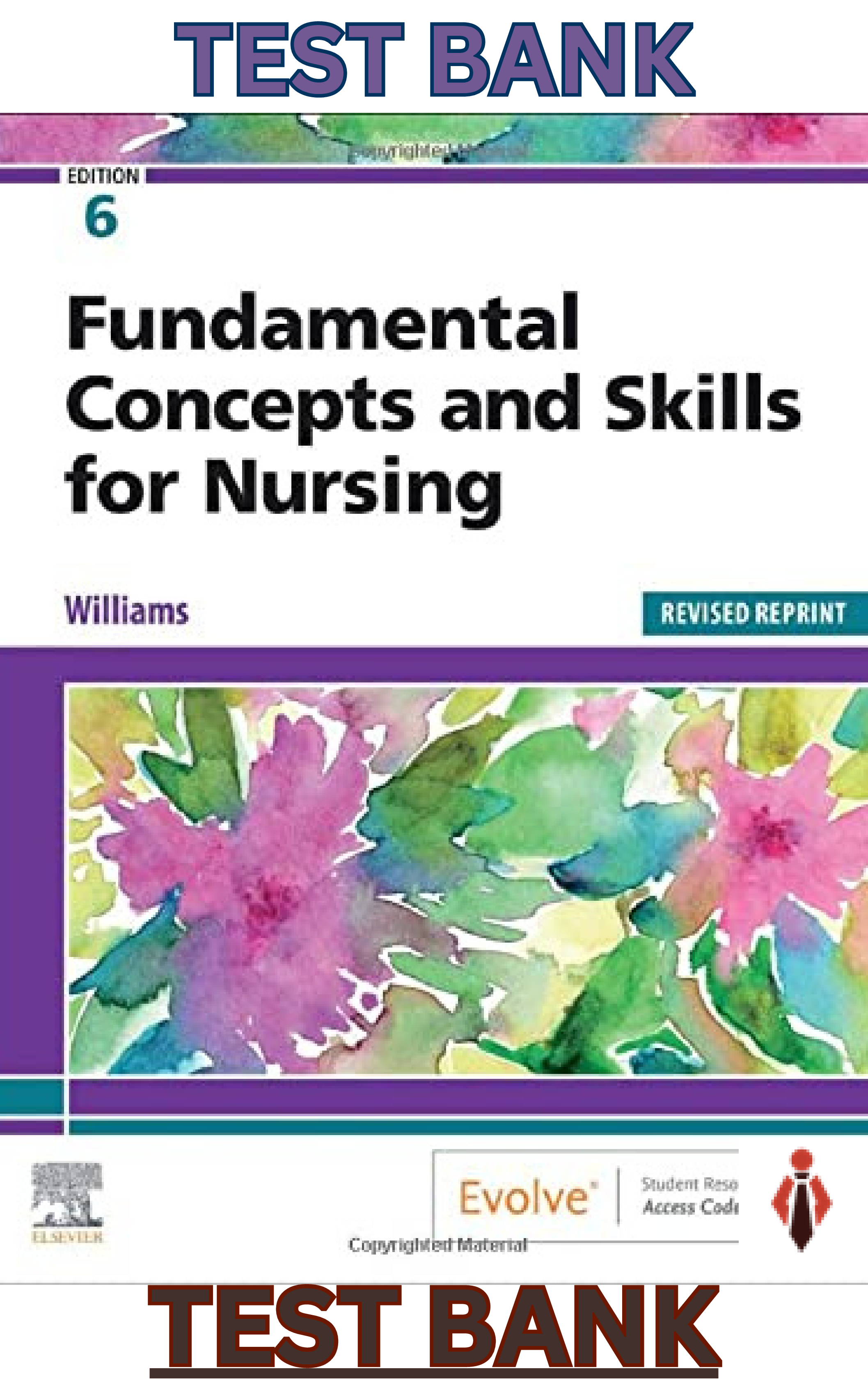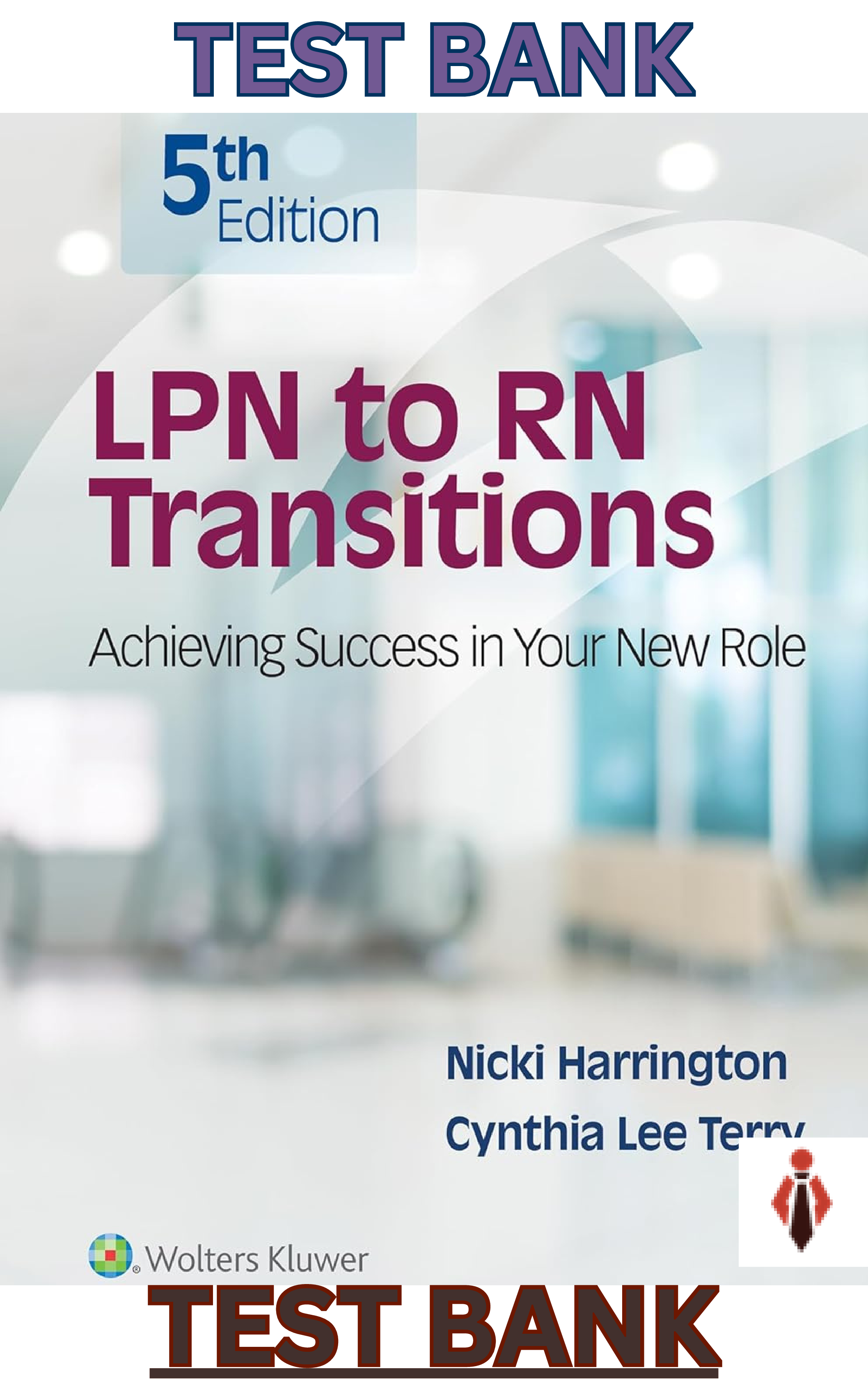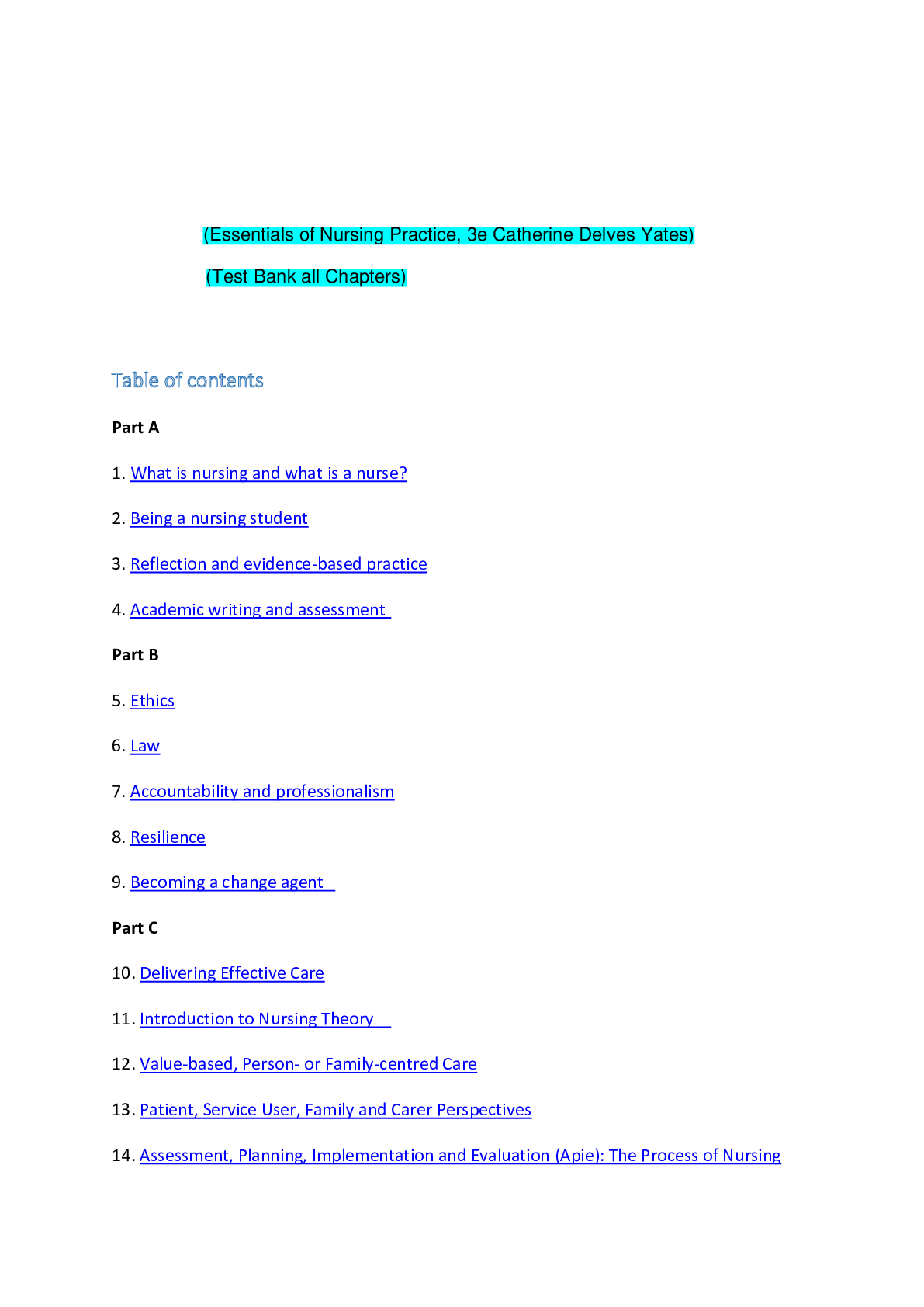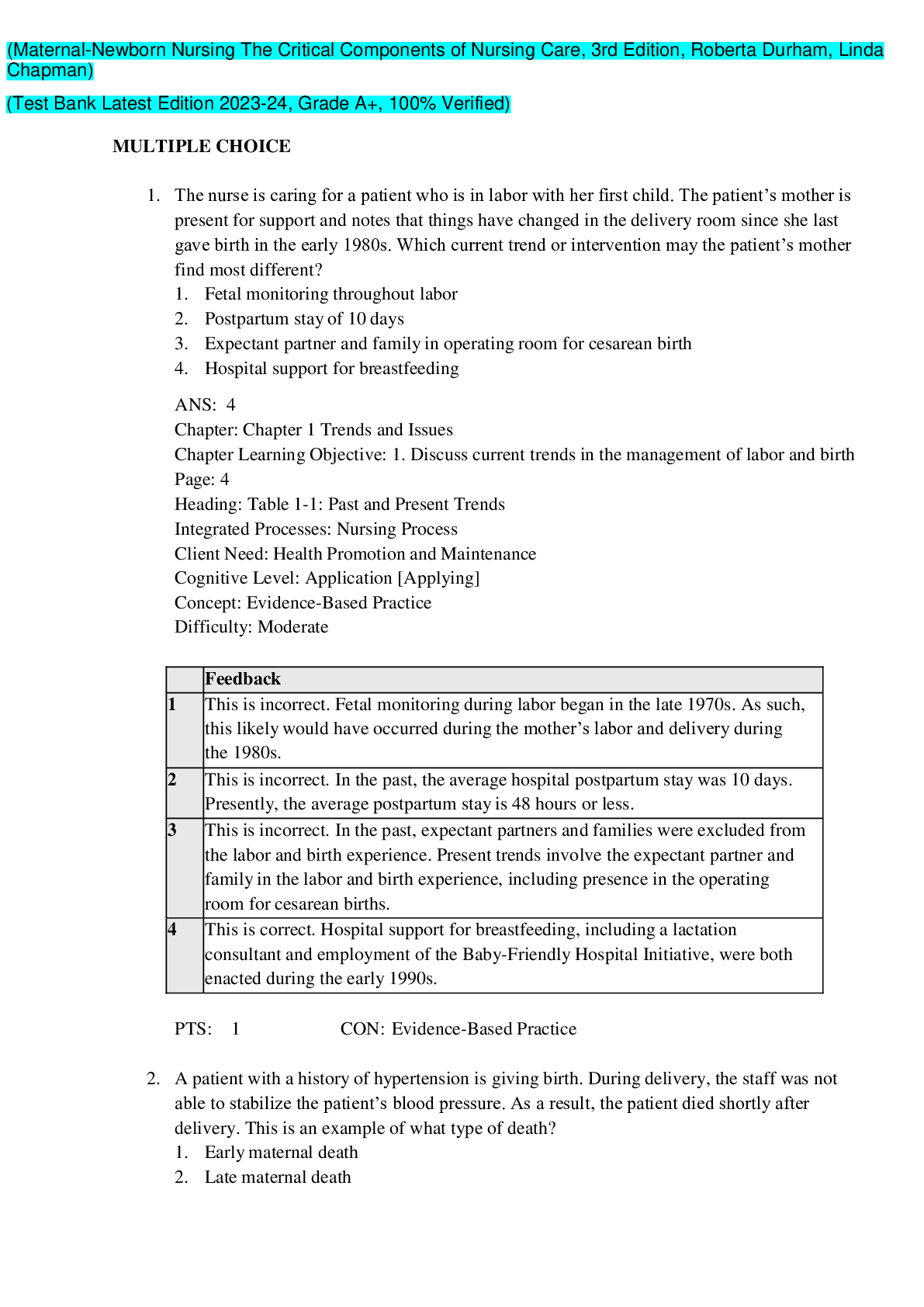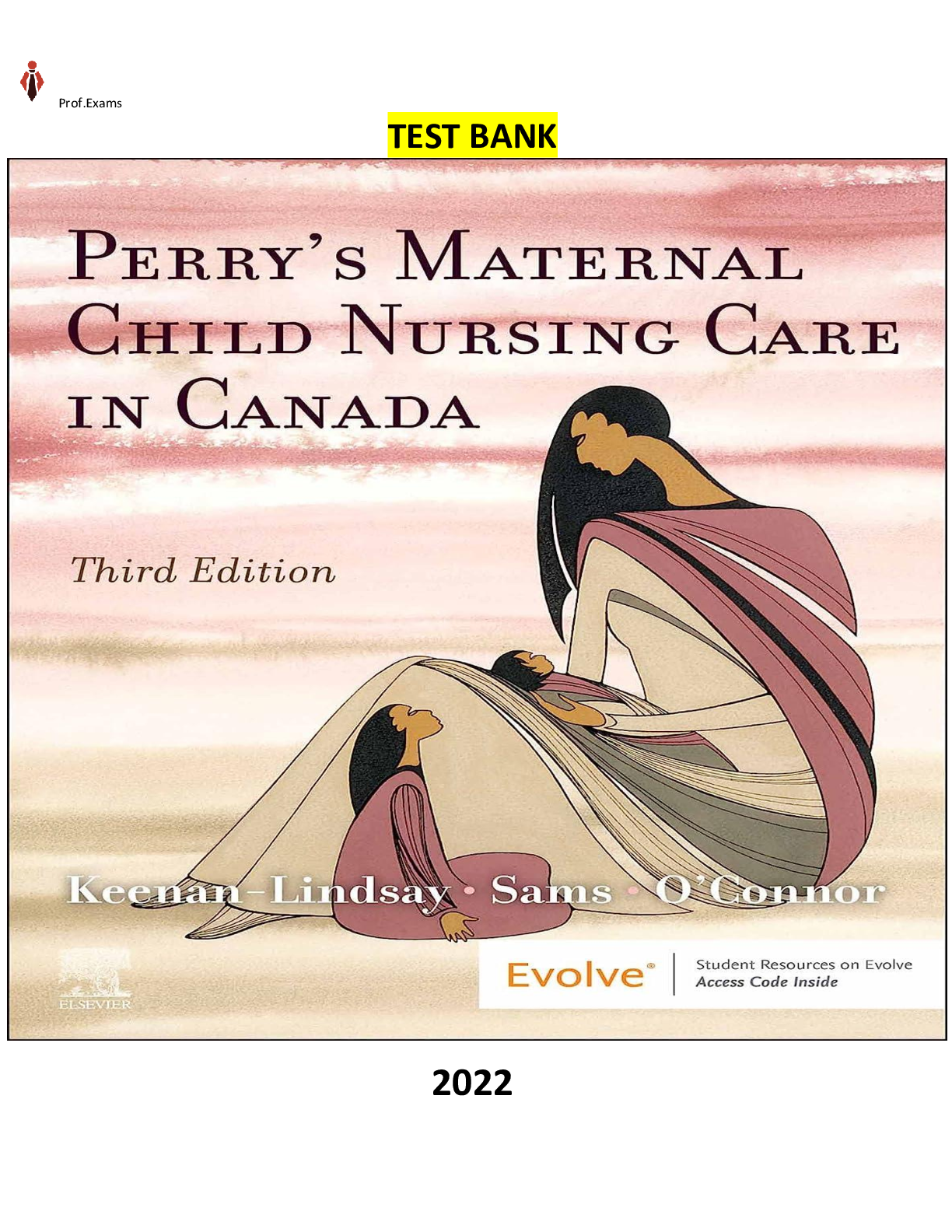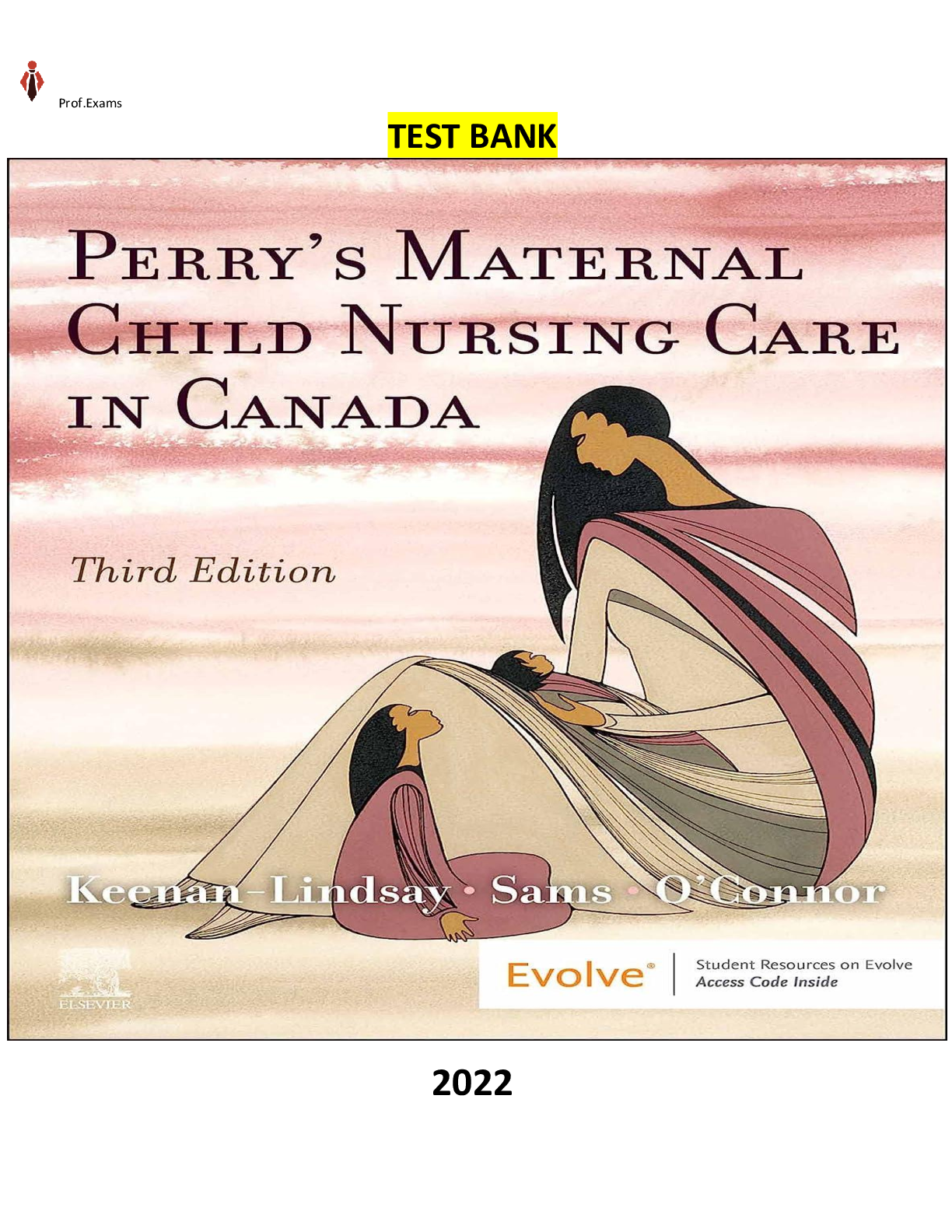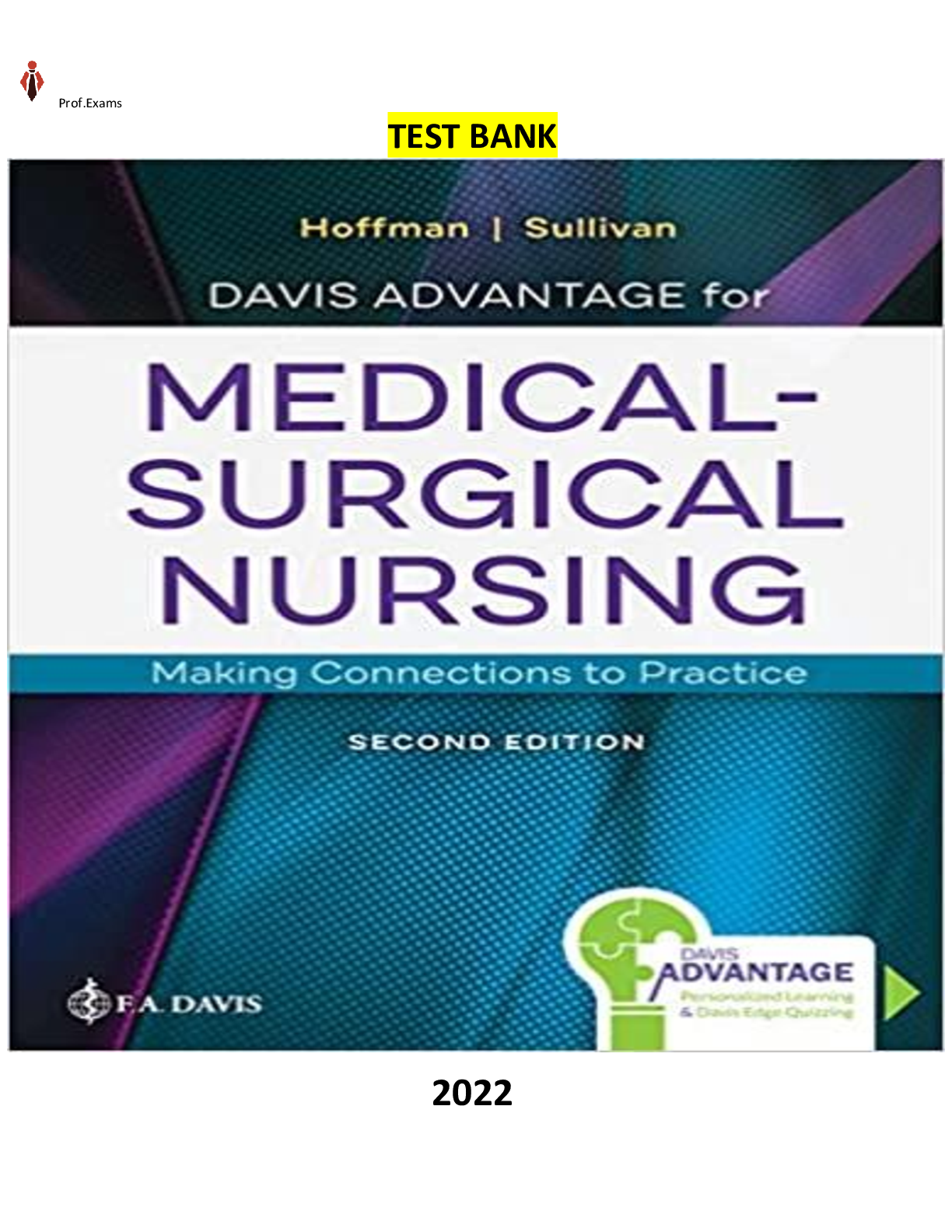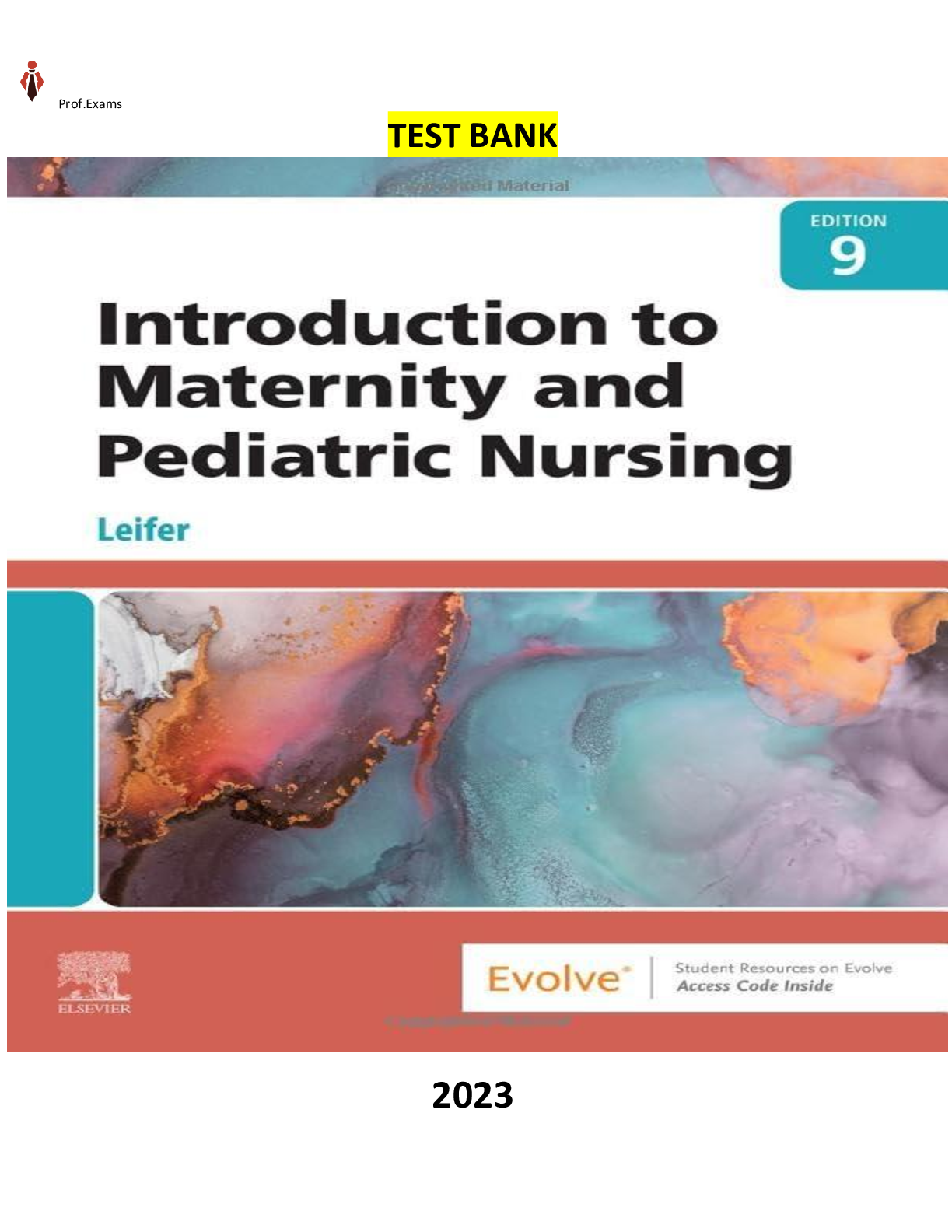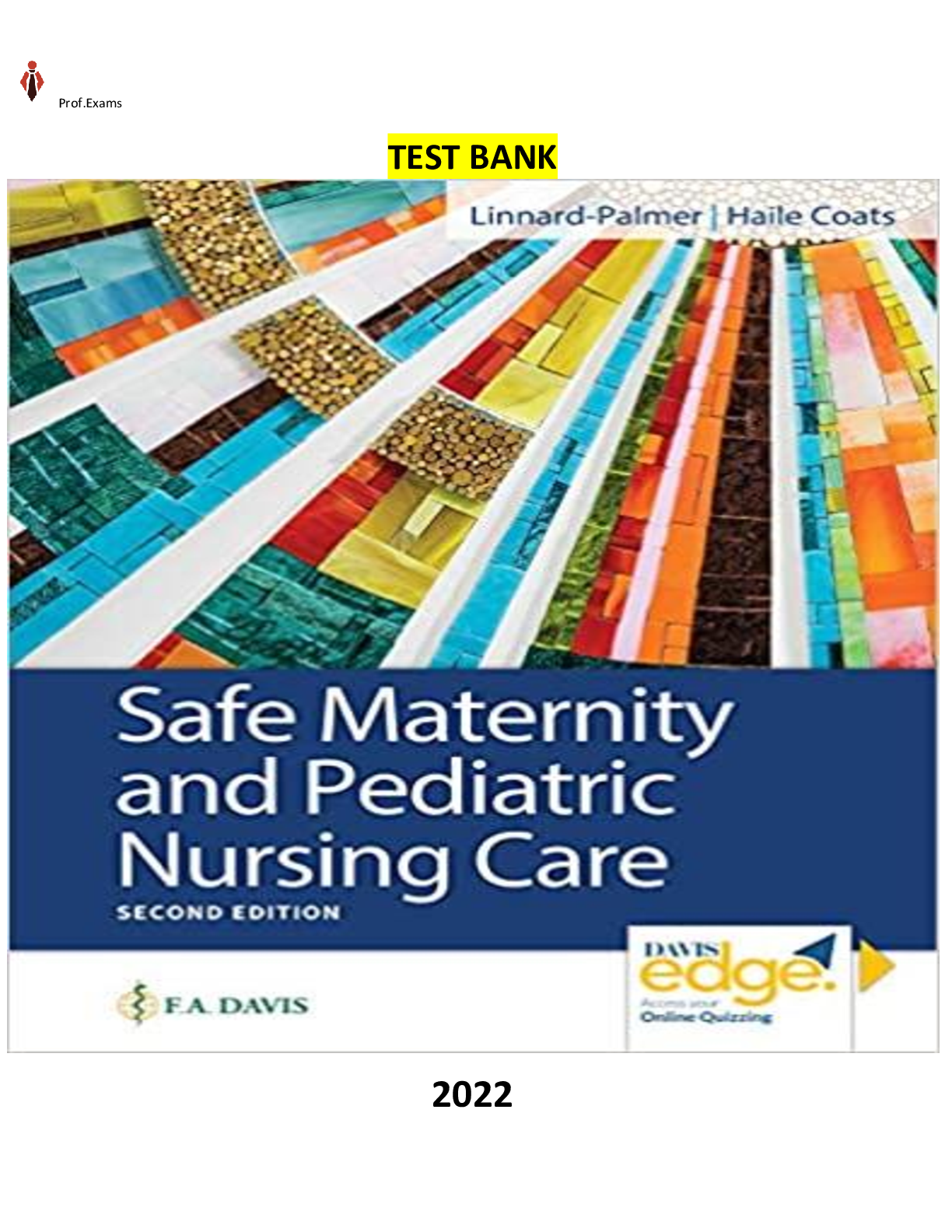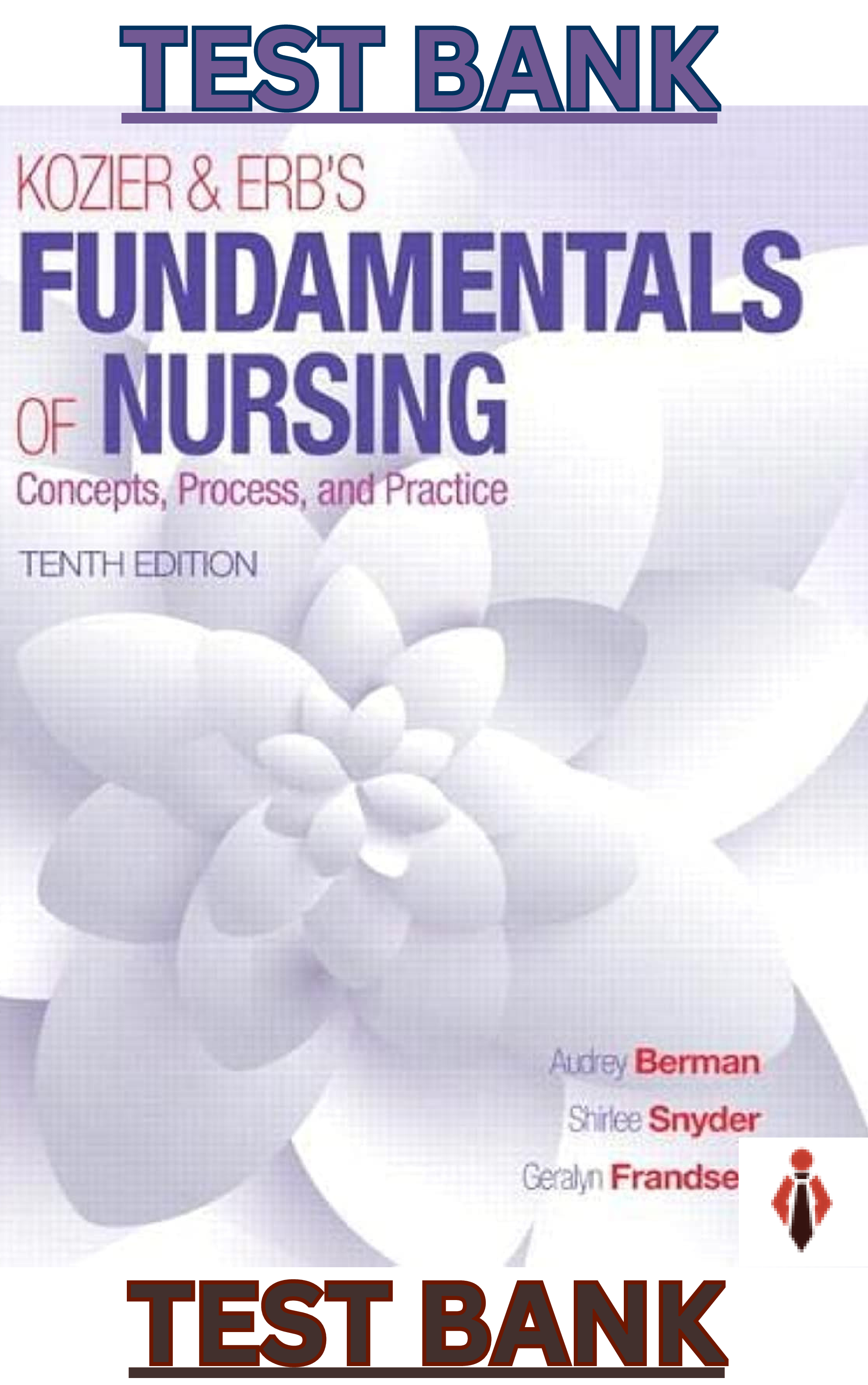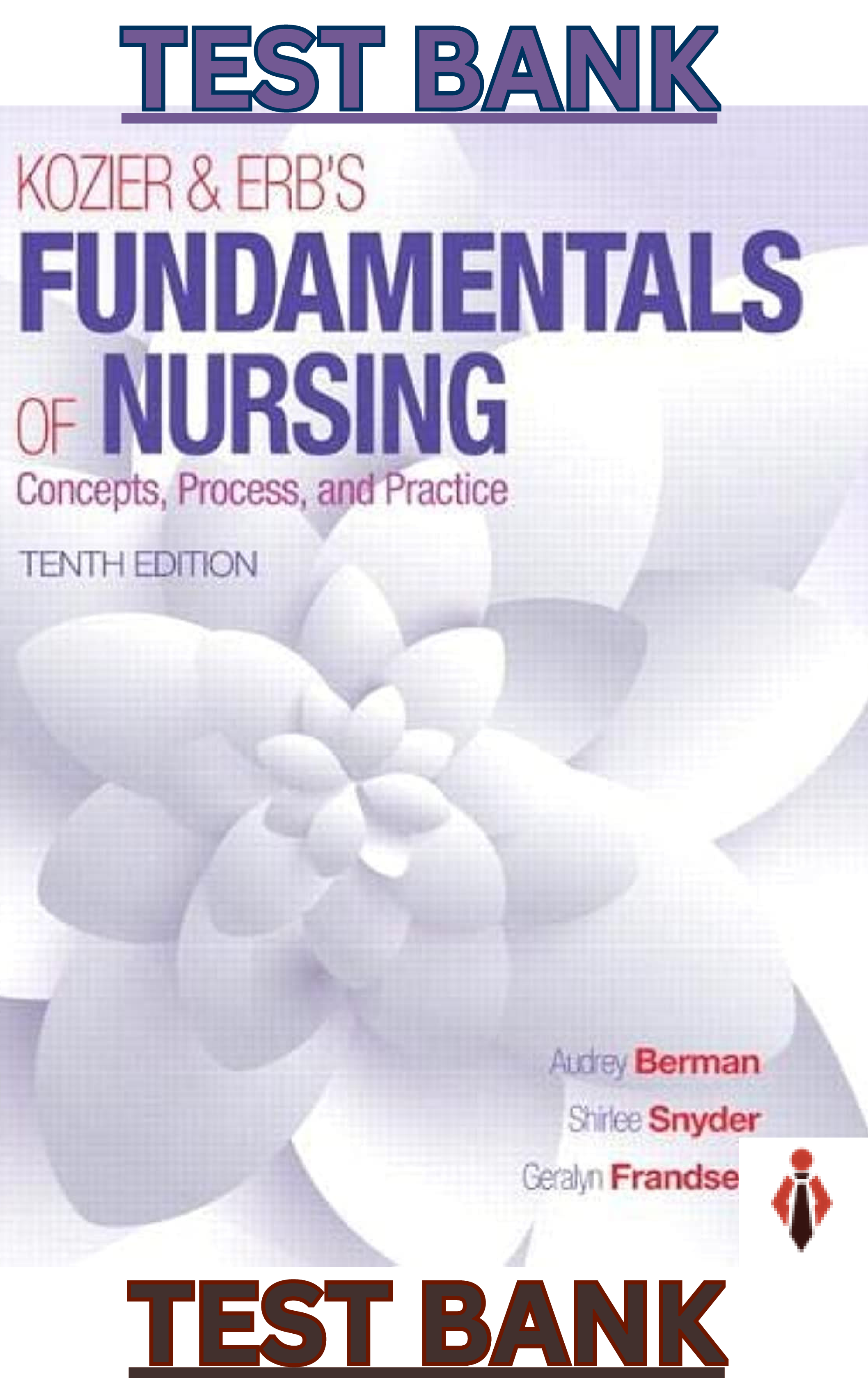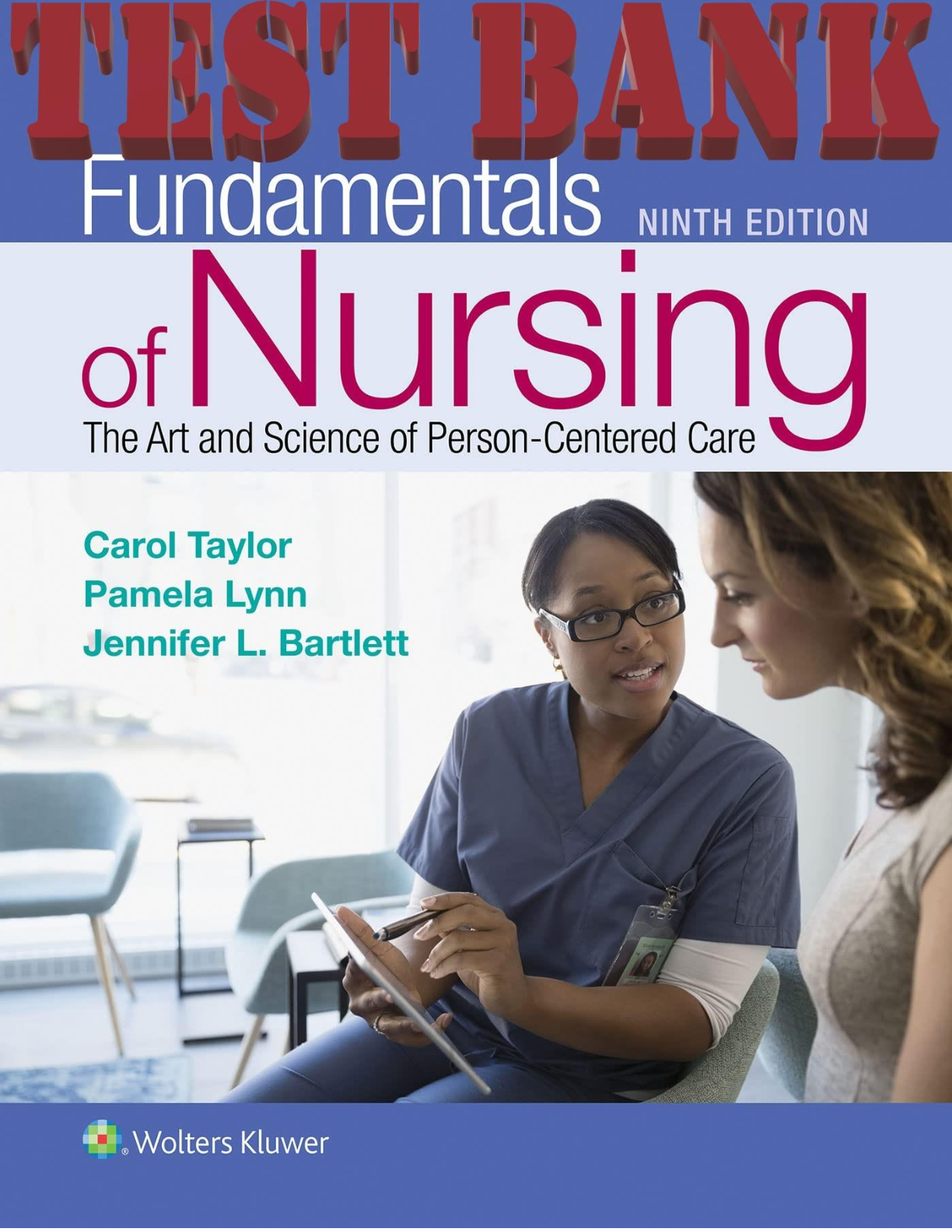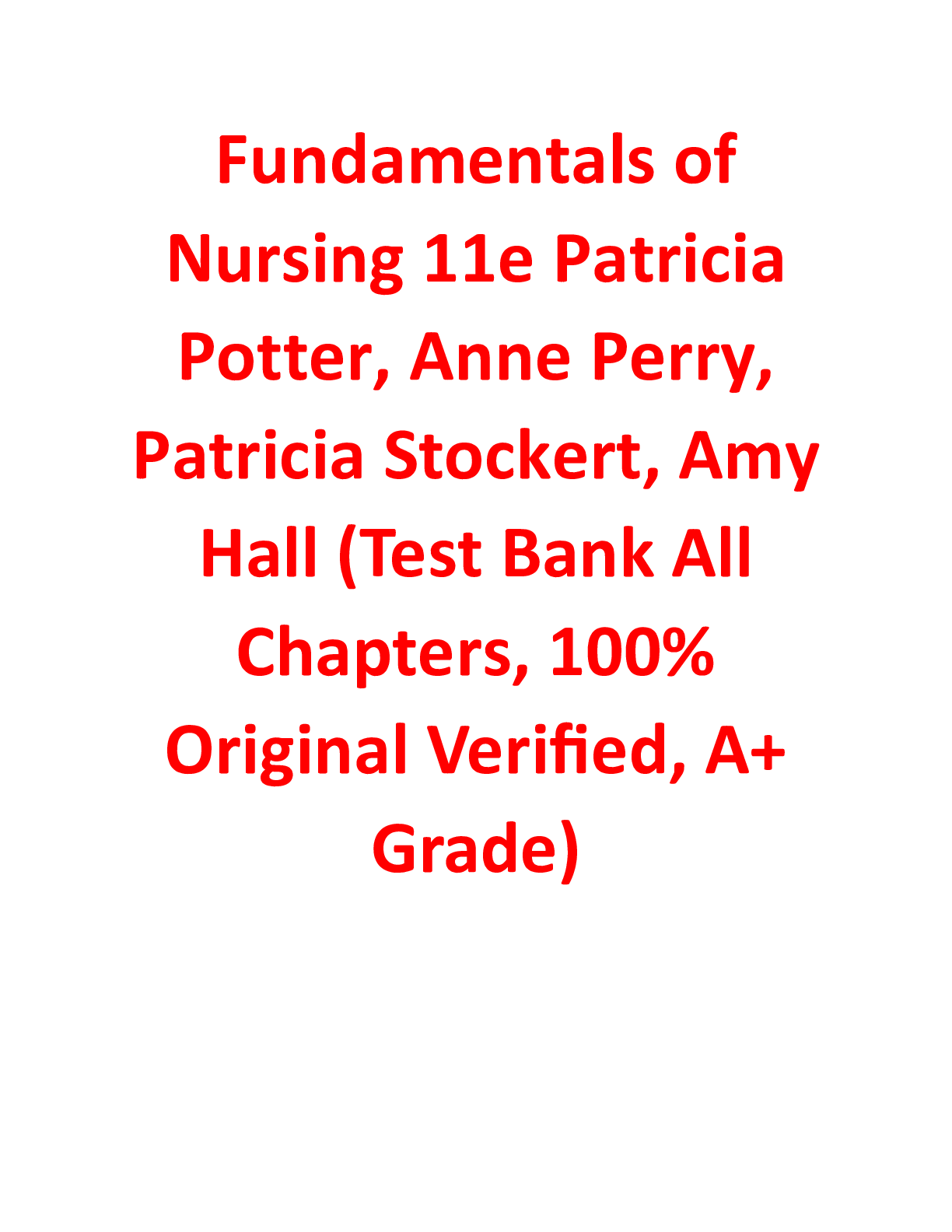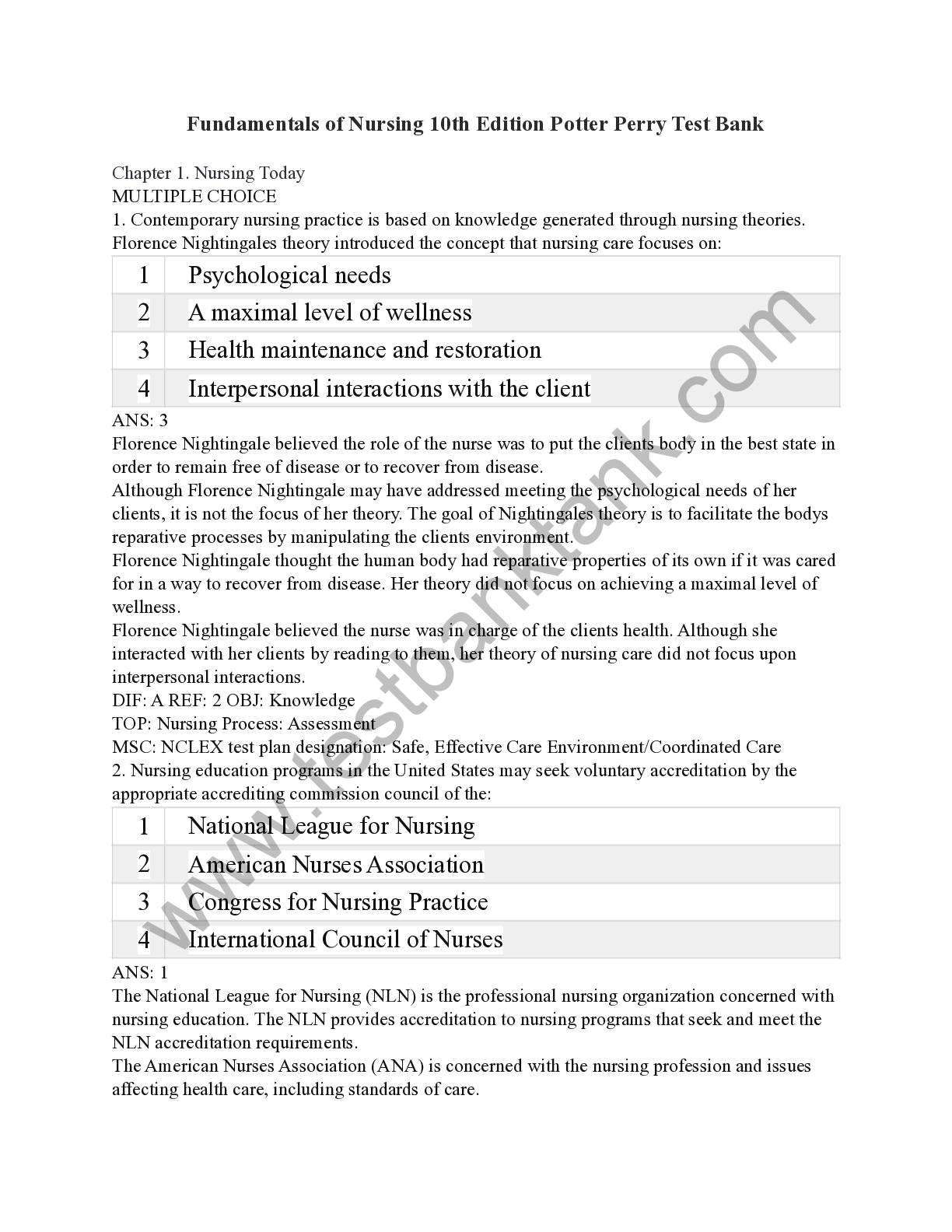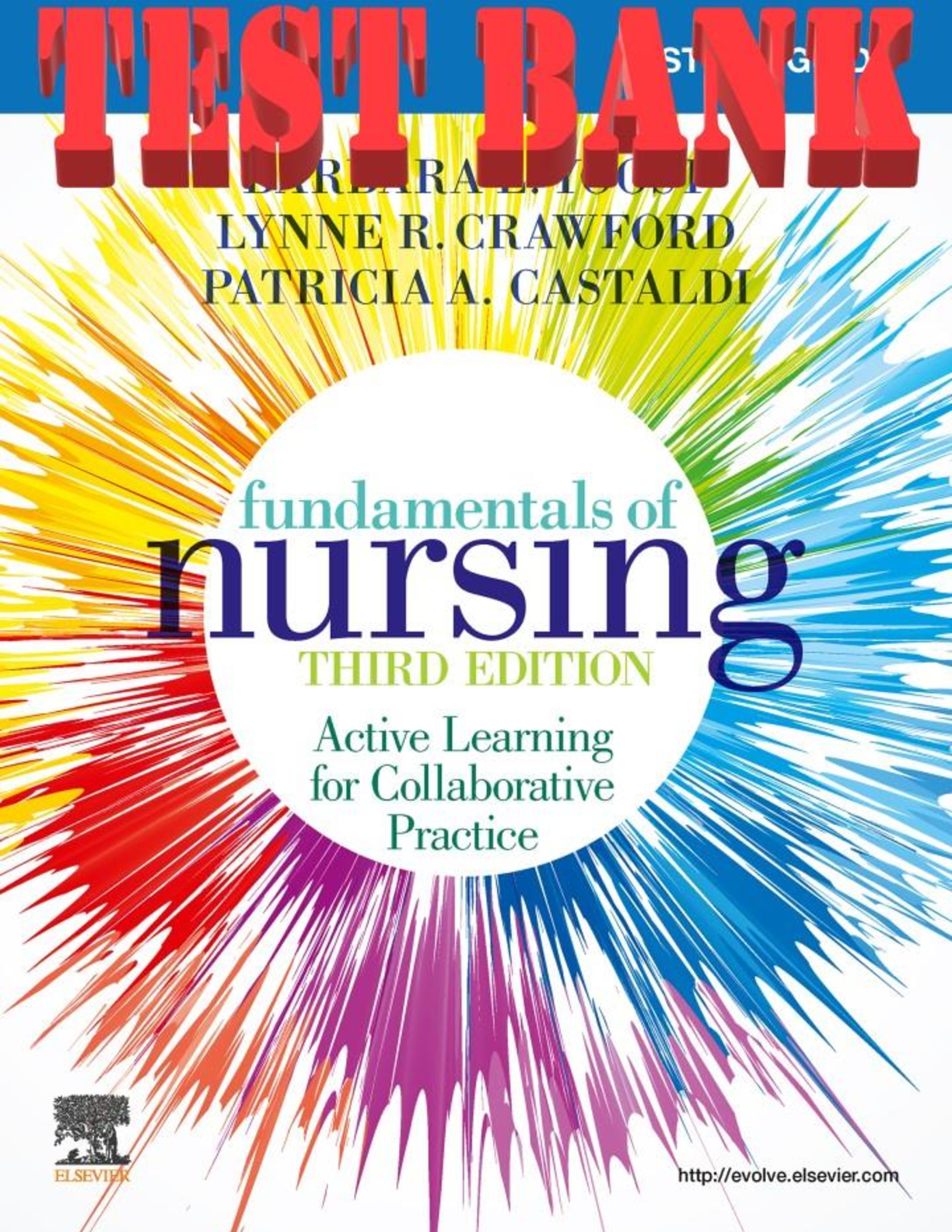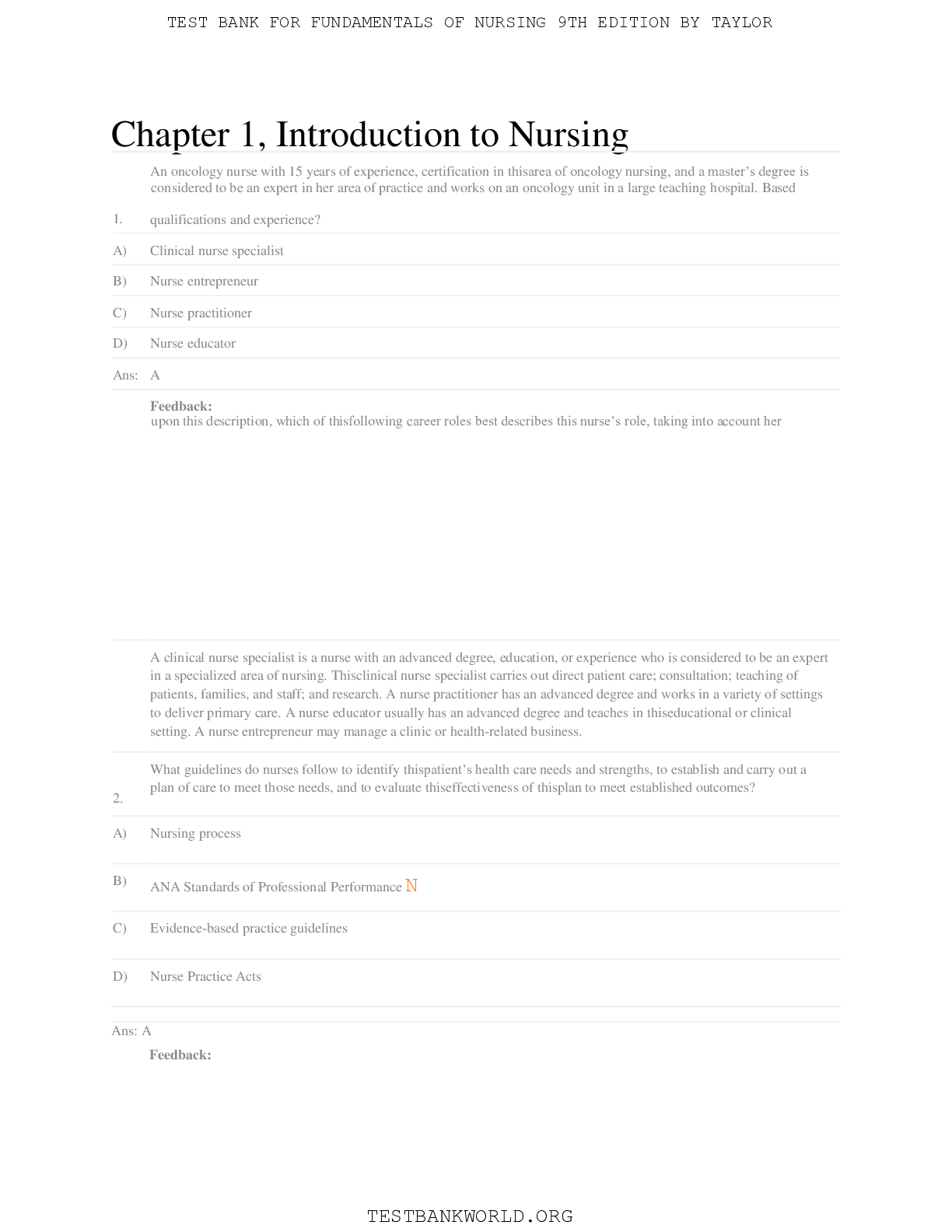*NURSING > TEST BANK > COMPLETE - Elaborated Test bank for Fundamentals of Nursing-Active Learning for Collaborative Practi (All)
COMPLETE - Elaborated Test bank for Fundamentals of Nursing-Active Learning for Collaborative Practice 3Ed.by Barbara L Yoost & Lynne R Crawford . ALL Chapters(1-42) Included |296| Pages - Questions & Answers Pass Basic Fundamentals of Nursing in First Attempt Guaranteed!Get 100% Latest Exam Questions, Accurate & Verified Answers to Pass the Actual Exam! Instant Download!
Document Content and Description Below
COMPLETE - Elaborated Test bank for Fundamentals of Nursing-Active Learning for Collaborative Practice 3Ed.by Barbara L Yoost & Lynne R Crawford . ALL Chapters(1-42) Included |296| Pages - Questions &... Answers Pass Basic Fundamentals of Nursing in First Attempt Guaranteed!Get 100% Latest Exam Questions, Accurate & Verified Answers to Pass the Actual Exam! Instant Download! COMPLETE - Elaborated Test bank for Fundamentals of Nursing-Active Learning for Collaborative Practice 3Ed.by Barbara L Yoost & Lynne R Crawford . ALL Chapters(1-42) Included |296| Pages - Questions & Answers Pass Basic Fundamentals of Nursing in First Attempt Guaranteed!Get 100% Latest Exam Questions, Accurate & Verified Answers to Pass the Actual Exam! Instant Download! Fundamentals of Nursing-Active Learning for Collaborative Practice 3Ed.by Barbara L Yoost & Lynne R Crawford ISBN-10 0323828094 ISBN-13 978-0323828093 Chapter 01: Nursing, Theory, and Professional Practice Chapter 02: Values, Beliefs, and Caring Chapter 03: Communication Chapter 04: Clinical Judgment in Nursing Chapter 05: Introduction to the Nursing Process Chapter 06: Assessment Chapter 07: Data Analysis/Nursing Diagnosis Chapter 08: Planning Chapter 09: Implementation and Evaluation Chapter 10: Documentation, Electronic Health Records, and Reporting Chapter 11: Ethical and Legal Considerations Chapter 12: Leadership and Management Chapter 13: Evidence-Based Practice and Nursing Research Chapter 14: Health Literacy and Patient Education Chapter 15: Nursing Informatics Chapter 16: Health and Wellness Chapter 17: Human Development: Conception Through Adolescence Chapter 18: Human Development: Young Adult Through Older Adult Chapter 19: Vital Signs Chapter 20: Health History and Physical Assessment Chapter 21: Ethnicity and Cultural Assessment Chapter 22: Spiritual Health Chapter 23: Public Health, Community-Based, and Home Health Care Chapter 24: Human Sexuality Chapter 25: Safety Chapter 26: Asepsis and Infection control Chapter 27: Hygiene and Personal Care Chapter 28: Activity, Immobility, and Safe Movement Chapter 29: Skin Integrity and Wound Care Chapter 30: Nutrition Chapter 31: Cognitive and Sensory Alterations Chapter 32: Stress and Coping Chapter 33: Sleep Chapter 34: Diagnostic Testing Chapter 35: Medication Administration Chapter 36: Pain Management Chapter 37: Perioperative Nursing Care Chapter 38: Oxygenation and Tissue Perfusion Chapter 39: Fluid, Electrolytes, and Acid-Base Balance Chapter 40: Bowel Elimination Chapter 41: Urinary Elimination Chapter 42: Death and Loss 1. The nurse identifies the concept of enduring ideas about what a person considers desirable or has worth in life is known by which term? a. Values b. First-order belief c. Higher order belief d. Stereotype ANS: A Values are enduring ideas about what a person considers is the good, the best, and the “right” thing to do and their opposites—the bad, worst, and wrong things to do—and about what is desirable or has worth in life. First-order beliefs serve as the foundation or the basis of an individual’s belief system. Higher order beliefs are ideas derived from a person’s first-order beliefs through inductive or deductive reasoning. A stereotype is a belief about a person, a group, or an event that is thought to be typical of all others in that category. DIF: Remembering REF: Concepts: Professionalism OBJ: 2.1 TOP: Nursing Process: Assessment MSC: NCLEX Client Needs Category: Safe and Effective Care Environment: Management of Care 2. A group of nursing students are discussing the history of nursing to a staff nurse. When a student states, “Yeah, nurses used to be called the doctors’ handmaidens.” the staff nurse recognizes that this comment is identified by which term? a. Prejudice b. Generalization c. Stereotype d. Belief ANS: C A stereotype is a belief about a person, a group, or an event that is thought to be typical of all others in that category. A prejudice is a preformed opinion, usually an unfavorable one, about an entire group of people that is based on insufficient knowledge, irrational feelings, or inaccurate stereotypes. In the process of learning, people form generalizations (general statements or ideas about people or things) to relate new information to what is already known and to categorize the new information, making it easier to remember or understand. A belief is a mental representation of reality or a person’s perceptions about what is right (correct), true, or real, or what the person expects to happen in a given situation. DIF: Understanding REF: Concepts: Professionalism OBJ: 2.1 TOP: Nursing Process: Evaluation MSC: NCLEX Client Needs Category: Safe and Effective Care Environment: Management of Care 3. A value system is a set of somewhat consistent values and measures that are organized hierarchically into a belief system on a continuum of relative importance. The nurse knows that a value system is also identified by which concept? a. It is culturally based. b. It is unique to each individual. c. It is a poor basis for making decisions. d. It is rigid and uniform within a culture. ANS: A Anthropologists and social scientists have noted that in every culture, a particular value system prevails and consists of culturally defined moral and ethical principles and rules that are learned in childhood. Everyone possesses a relatively small number of values and may share the same values with others, but to different degrees. A value system helps the person choose between alternatives, resolve values conflicts, and make decisions. Within every culture, however, values vary widely among subcultural groups and even between individuals on the basis of the person’s gender, personal experiences, personality, education, and many other variables. DIF: Remembering REF: Concepts: Professionalism OBJ: 2.1 TOP: Nursing Process: Assessment MSC: NCLEX Client Needs Category: Psychosocial Integrity 4. The nurse is caring for a patient who is under arrest for murder and is attempting to perform nursing care duties while, at the same time, feeling a sense of repugnance toward the patient. The nurse recognizes this situation is identified by which term? a. Values clarification b. Values conflict c. First-order beliefs d. Higher order beliefs ANS: B A values conflict occurs when a person’s values are inconsistent with his or her behaviors or when the person’s values are not consistent with the choices that are available. Providing care for a convicted murderer may elicit troubling feelings for a nurse, resulting in a values conflict between the nurse’s commitment to care for all people and a personal repugnance for the act of murder. Values clarification is a therapeutic process that allows individuals to consider, clarify, and prioritize their personal values. First-order beliefs serve as the foundation or the basis of an individual’s belief system. Higher order beliefs are ideas derived from a person’s first-order beliefs, inductive, or syllogistic reasoning. DIF: Understanding REF: Concepts: Professionalism OBJ: 2.1 TOP: Nursing Process: Diagnosis MSC: NCLEX Client Needs Category: Psychosocial Integrity 5. While helping patients with values clarification and care decisions, the nurse should complete which action? a. Convince the patient to do what the nurse believes is best. b. Give advice about what the nurse would do. c. Tell the patient what the right thing to do is. d. Provide information so the patient can make informed decisions. ANS: D While helping patients with values clarification and care decisions, nurses must be aware of the potential influence of their professional nursing role on patient decision-making. Nurses should be careful to assist patients to clarify their own values in reaching informed decisions. Providing information to patients so that they can make informed decisions is a critical nursing role. Giving advice, trying to convince the patient that the nurse knows best, or telling patients what to do in difficult circumstances are approaches that are unethical and ill-advised. DIF: Applying REF: Concepts: Professionalism OBJ: 2.2 TOP: Nursing Process: Implementation MSC: NCLEX Client Needs Category: Psychosocial Integrity 6. A patient with terminal cancer says to the nurse, “I just don’t know if I should allow CPR in the event I quit breathing. What do you think?” Which statement by the nurse would be most beneficial to the patient? a. “If it were me, I would want to live no matter what.” b. “Don’t worry. You have plenty of time to decide that later on.” c. “It’s totally up to you. Have you discussed this with your family?” d. “Let’s talk about what CPR means to you.” ANS: D The use of the value clarification process is helpful when assisting patients in making health care decisions regarding end-of-life care. Giving advice or telling patients what to do is unethical and not recommended. Ignoring a patient concern or changing the subject is inappropriate. Patients should be given factual information in order for them to make their own decisions. DIF: Applying REF: Concepts: Professionalism OBJ: 2.2 TOP: Nursing Process: Implementation MSC: NCLEX Client Needs Category: Psychosocial Integrity 7. The nurse is observed sitting at the bedside of a patient discussing the nursing care plan for the shift. The nurse identifies which theory or model most accurately reflects this nurse–patient relationship? a. Swanson’s Theory of Caring b. Boykin and Schoenhofer’s Theory of Nursing as Caring c. Watson’s Theory of Human Caring d. Leininger’s Theory of Cultural Care Diversity and Universality ANS: A Swanson’s five caring processes include being with and enabling. Sitting at the bedside and sharing information are activities that exemplify these behaviors. Boykin and Schoenhofer’s Theory of Nursing in Caring sees caring as the intentional and authentic presence of the nurse with another who is recognized as person living caring and growing in caring. Watson’s Theory of Caring impacts both the person and the universe and is built upon 10 caritas processes. Leininger’s theory is based on several beliefs including but not limited to the following assumptions: care is a central unifying focus of nursing; a cure cannot occur without caring; culture is embedded in all aspects of one’s being; and culturally congruent care promotes health and well-being. DIF: Understanding REF: Concepts: Professionalism OBJ: 2.4 TOP: Nursing Process: Diagnosis MSC: NCLEX Client Needs Category: Psychosocial Integrity 8. The student nurse is planning care for a patient who believes that Western medicine is effective but not always accurate and recognizes which nursing theory would best explain the patient’s health practices? a. Nursing: Human Science and Human Care b. Theory of Cultural Care Diversity and Universality c. Theory of Nursing as Caring d. Five caring processes ANS: B Leininger’s theory is based on several beliefs including but not limited to the following assumptions: care is a central unifying focus of nursing; a cure cannot occur without caring; culture is embedded in all aspects of one’s being; and culturally congruent care promotes health and well-being. Swanson’s five caring processes include maintaining belief, knowing, being with, doing for, and enabling. In the Theory of Nursing as Caring, Boykin and Schoenhofer note that caring is defined as “the intentional and authentic presence of the nurse with another who is recognized as person living caring and growing in caring.” Watson’s Theory of Human Caring impacts both the person and the universe and is built upon 10 caritas processes. DIF: Understanding REF: Concepts: Professionalism OBJ: 2.4 TOP: Nursing Process: Diagnosis MSC: NCLEX Client Needs Category: Psychosocial Integrity 9. The nurse identifies which nursing theorist/theorists who describes/describe the nurse–patient relationship as a situation in which the nurse and patient share the lived experience of caring? a. Kristen Swanson b. Jean Watson c. Madeleine Leininger d. Anne Boykin & Savina Schoenhofer ANS: D In the Theory of Nursing as Caring (Boykin & Schoenhofer, 2015), caring is defined as “the intentional and authentic presence of the nurse with another who is recognized as person living caring and growing in caring” (Boykin & Schoenhofer, 2001, p. 13), and “the general intention of nursing as a practiced discipline is nurturing persons living caring and growing in caring” (Boykin & Schoenhofer, 2015, p. 343). One of the major concepts of the theory is the nursing situation in which the nurse and patient share the lived experience of caring. It is in this nursing situation that nursing is created and can best be understood. The model has been used in a variety of settings to guide practice, education, and research. Leininger’s theory is based on several beliefs including but not limited to the following assumptions: care is a central unifying focus of nursing; a cure cannot occur without caring; culture is embedded in all aspects of one’s being; and culturally congruent care promotes health and well-being. Swanson’s five caring processes include maintaining belief, knowing, being with, doing for, and enabling. Watson’s Theory of Human Caring impacts both the person and the universe and is built upon 10 caritas processes. DIF: Remembering REF: Concepts: Professionalism OBJ: 2.4 TOP: Nursing Process: Assessment MSC: NCLEX Client Needs Category: Psychosocial Integrity.. [Show More]
Last updated: 11 months ago
Preview 1 out of 274 pages
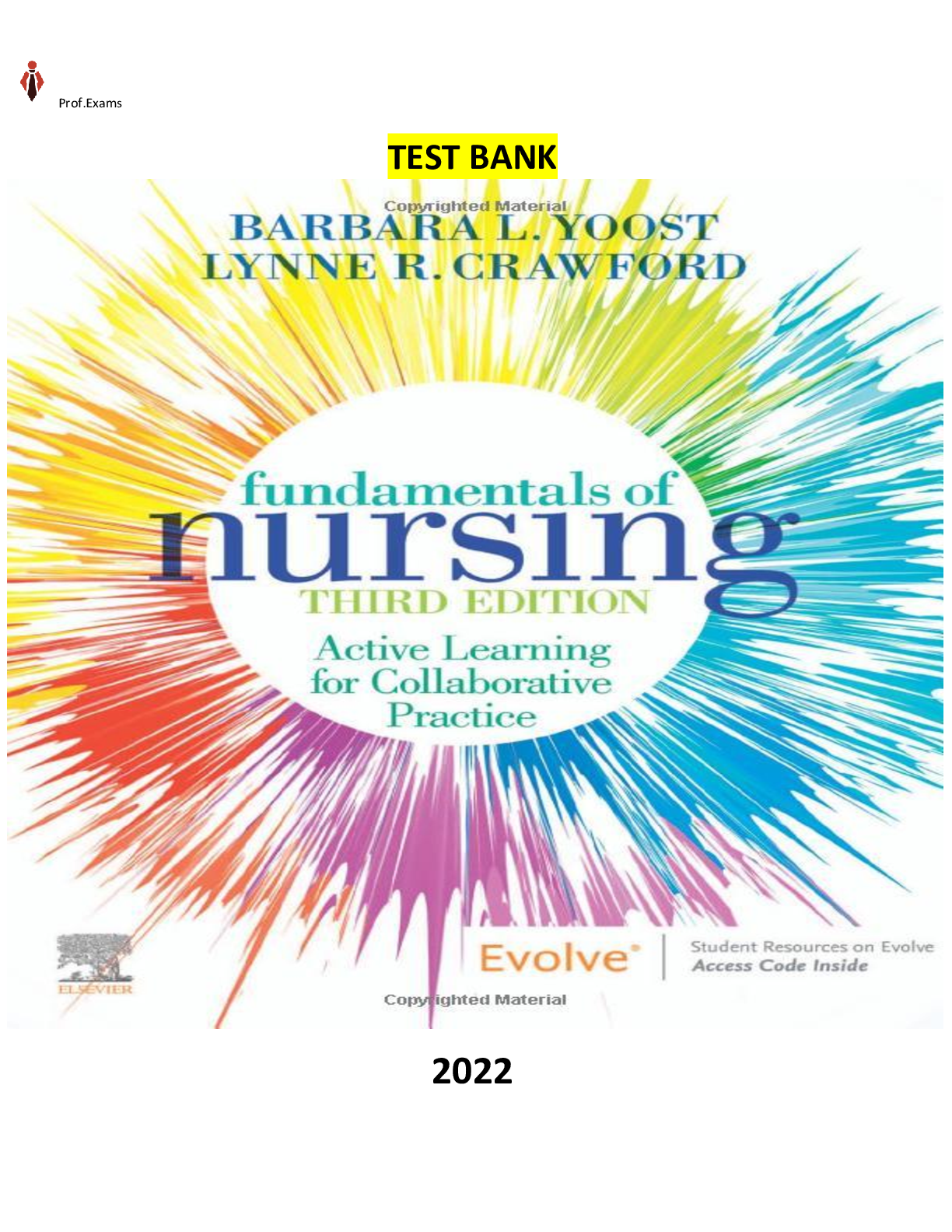
Reviews( 0 )
Document information
Connected school, study & course
About the document
Uploaded On
May 16, 2023
Number of pages
274
Written in
Additional information
This document has been written for:
Uploaded
May 16, 2023
Downloads
0
Views
123


